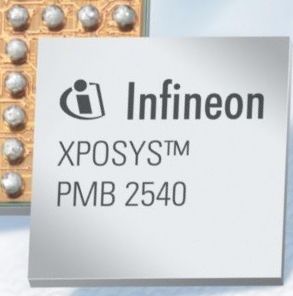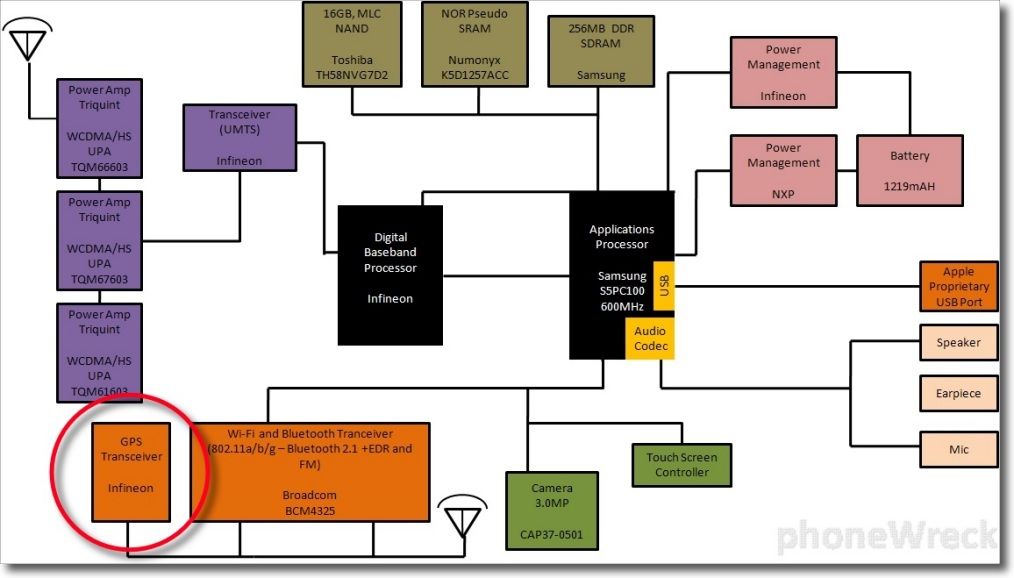Following my article 8 November 2009 the accuracy of couple iNavX / iPhone, I tried to explore the subject, and I give you the result of my investigations. Warning it may take time !
The built-in GPS chipset in the iPhone is an A-GPS specially designed for mobile phones. This requires some explanation and some technical.
The A-GPS :
An example of system A-GPS is that the iPhone 3G, that uses a chipset Infineon « Hammerhead II » for navigation.
A-GPS chipset intended for "smartphones" :
 The PMB2525 « Hammerhead II », developed by Infineon and Global Locate, was launched in January 2007 and fit out the iPhone 3G. It occupies a < 50mm ² and has a sensitivity of 160 dBm
The PMB2525 « Hammerhead II », developed by Infineon and Global Locate, was launched in January 2007 and fit out the iPhone 3G. It occupies a < 50mm ² and has a sensitivity of 160 dBm
June 2007 Broadcom bought Global Locate, and develops chipset BCM4750, an area of 35mm ² and a sensitivity of 162 dBm, presented in July 2008, fit out recently TomTom.
In turn, Infineon and Epson associated deliver a new chipset PMB2540 « XPOSYS » February 2009, six months before the launch of the iPhone 3G. It surpassed its predecessor with a place occupied < 26mm ² and a sensitivity of 165dBm.
 It remains unclear if this last one has replaced the Hammerhead II on iPhone 3G, Apple keeps silence about it, but it is very likely when we compare the sizes of the GPS modules on the motherboards of both devices and the improvement of the GPS position relative to the previous model. What is however certain, is the presence of the module combo WiFi / Bluetooth Broadcom BCM4325 on the 3GS.
It remains unclear if this last one has replaced the Hammerhead II on iPhone 3G, Apple keeps silence about it, but it is very likely when we compare the sizes of the GPS modules on the motherboards of both devices and the improvement of the GPS position relative to the previous model. What is however certain, is the presence of the module combo WiFi / Bluetooth Broadcom BCM4325 on the 3GS.
Note that in an exchange of mail with a blogger in July 2008, Bob Borchers, senior director of worldwide marketing for iPhone products, indicated that the chipset of the 3G iPhone was low and that the antenna was small. He also clarified that the apparent circle of metal around the lens of the camera was part of the GPS antenna. That time, Apple does not consider the iPhone as GPS to provide a step by step navigation solution (turn to turn).
The processing software of the iPhone :
The iPhone uses a mix of two mechanisms of location : one based on geolocation provided by the cellular antennas, and the other based on the built-in A-GPS chipset.
![]() So when location services are activated the first time, iPhone gives preference to the position from the nearest cellular antenna but with an accuracy up to a kilometer or more because you can be anywhere within the radius of this antenna. This location is represented by a blue button (blue-dot) ringed with a blue area of variable size depending on the accuracy calculated.
So when location services are activated the first time, iPhone gives preference to the position from the nearest cellular antenna but with an accuracy up to a kilometer or more because you can be anywhere within the radius of this antenna. This location is represented by a blue button (blue-dot) ringed with a blue area of variable size depending on the accuracy calculated.
![]() Once the iPhone fixes the position given by GPS, it takes precedence over the cellular network, position icon will change to a blue button circled by a blue ring driven by a rhythmic movement of expansion.
Once the iPhone fixes the position given by GPS, it takes precedence over the cellular network, position icon will change to a blue button circled by a blue ring driven by a rhythmic movement of expansion.
Sometimes, even in an area unobstructed, iPhone will not switch to GPS mode and can wait awhile before getting the desired precision. The thing to do in this case seems to restart the location services in the settings of the iPhone and then restart the application. However, Apple seems to use some magic code not documented in Maps application (Google Maps) which can always be quickly obtain an accurate position (GPS). One method is to seek first the position in Maps (icon in the lower left) and then start the application you wish to use (iNavX, in example). This works surprisingly !
Preliminary Conclusions :
There is therefore a safe bet with chipsets with such theoretical performance on manufacturer documentation, problems of inaccuracies and / or temporary stalls that I found to be linked, not to the physical integration, but the treatment program designed by Apple. Mainly treatment selection positioning mode cellular / GPS.
With the iPhone 3G, the position accuracy of GPS is excellent outcome, less 5 meters high, found out with Maps on a long motorway journey. But once you are in town, or cellular signals are paramount, accuracy degrades sometimes rocking mode cellular geolocation. In coastal shipping, The same phenomenon is likely to occur when the iPhone goes in range of a cellular network powerful.
Unfortunately, no compelling evidence does not allow me to date to substantiate this deduction. Perhaps we shall find-an improvement in a future firmware update for the iPhone, who knows ?
[Update 24 August 2010]
I have seen at sea that the reception of GPS was markedly improved since the Update iOS 4. No more unexpected fix loss, even near the coast where the cellular locaion can be activated. My hypothesis was therefore justified, Apple has made a definite improvement of the processing software localization services.
[Update 20 August 2011]
See the recent post : iPhone built-in GPS : a formidable accuracy !
–––



